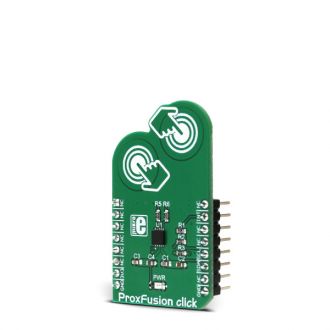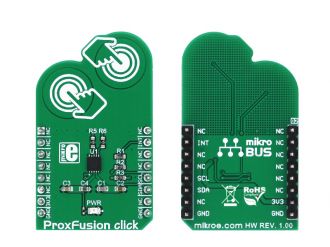
We strongly encourage users to use Package manager for sharing their code on Libstock website, because it boosts your efficiency and leaves the end user with no room for error. [more info]

Rating:
Author: MIKROE
Last Updated: 2018-04-17
Package Version: 1.0.0.1
mikroSDK Library: 1.0.0.0
Category: Capacitive
Downloaded: 10355 times
Not followed.
License: MIT license
ProxFusion click is a multifunctional capacitive and Hall-effect sensor device. This click can detect touch by using two onboard sensor pads, and it can sense a rotation angle of a magnetic field, parallel with the surface of the click board.
Do you want to subscribe in order to receive notifications regarding "ProxFusion click" changes.
Do you want to unsubscribe in order to stop receiving notifications regarding "ProxFusion click" changes.
Do you want to report abuse regarding "ProxFusion click".


Library description
Key functions
void proxfusion_systemSetting(uint8_t value) - Sets up system settings
uint8_t proxfusion_Touch() - Reads info about the touch
uint16_t proxfusion_getTemperature() - Reads current temperature
The application is composed of three sections :
void applicationTask()
{
touch = proxfusion_Touch();
if( touch == 1 )
mikrobus_logWrite("Touch 1",_LOG_LINE);
if( touch == 2 )
mikrobus_logWrite("Touch 2",_LOG_LINE);
if ( touch == 3 )
mikrobus_logWrite("Touch antenna",_LOG_LINE);
Delay_100ms();
}
Other MikroElektronika Libraries used in the example:
Additional notes and information
Depending on the development board you are using, you may need USB UART click, USB UART 2 click or RS232 click to connect to your PC, for development systems with no UART to USB interface available on the board. The terminal available in all MikroElektronika compilers, or any other terminal application of your choice, can be used to read the message.